|
 Suillus grevillei Suillus grevillei
SynonymsSuillus elegans
Boletus elegans
Boletus grevillei
BiostatusPresent in region - Exotic
Images (click to enlarge)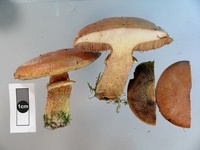
Owner: J.A. Cooper | 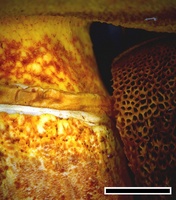
Caption: scale=5mm. Ring, stem apex and pores
Owner: J.A. Cooper | 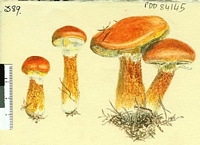
Owner: G.M. Taylor | 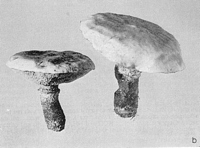
Caption: Fig. 3 - b, Suillus grevillei (x 1/2) | 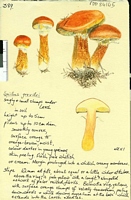
Caption: Watercolour
Owner: G.M. Taylor | 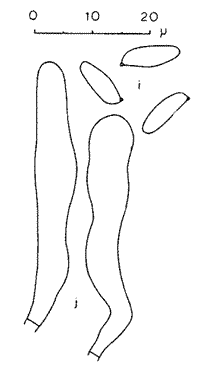
Caption: Fig. 2 - i, j, S. grevillei: i, spores; j, cystidia. | 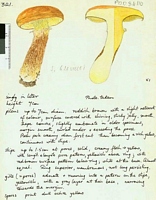
Caption: Watercolour
Owner: G.M. Taylor |
Article: Stevenson, G. (1962) [1961]. The Agaricales of New Zealand: I. Kew Bulletin 15(3): 381–385.
Description: Pileus up to 8 cm. diam., glutinous, bright yellow ochre to dull ochre, flesh creamy yellow, darkening slightly when cut. Pores up to 1 mm. or more in diam. and to 8 mm. long, yellow, slightly or strongly decurrent. Stipe 1-2 X 5-10 cm., yellow to yellow-ochre, conspicuous membranous ring with the stipe usually thickened under the ring, colour darker below the ring except at the base which is often white. Spores 8-10 X 3-4um.
Habitat: common in plantations of Larix decidua.
Notes: This fungus appears to correspond with figs. 10, 12 and 18 of Kallenbach's illustrations (t. 17) of Boletus elegans (flavus). (Typical S.flavidus (Fr.) Singer is a smaller, more tawny fungus of moist Pinus woods in the northern hemisphere)
Article: McNabb, R.F.R. (1968). The Boletaceae of New Zealand. New Zealand Journal of Botany 6(2): 137-176 (http://www.rsnz.org/publish/abstracts.php).
Description: PILEUS: convex
to plano-convex, 5-15 cm diam., mucilaginous, glabrous, golden brown, often
paling toward margin, frequently streaked or blotched with lemon yellow or golden
yellow; cuticle an ixotrichodermium, readily separable, composed of gelatinised,
hair-like, septate hyphae 3.5-6 µm diam.; margin typically entire, occasionally
lacerate. HYMENOPHORE: tubes to 11 mm long, adnate to subdecurrent, lemon yellow
to golden yellow; pores concolorous with tubes, angular, 0.5-1 mm diam., becoming
brownish where damaged. STIPE: 4.5-10 cm long, equal or tapering apically, 1-2.3
cm diam., solid, finely but distinctly reticulate above annulus, subpruinose
or subglabrous below, concolorous with pores apically, yellow, golden brown
or brownish below; glandulae absent: flesh pallid yellow; annulus typically
conspicuous, rarely absent, superior, pallid yellow or brownish yellow.
SPORES: spore print
yellowish brown (between Sayal Brown and Cinnamon); spores pallid melleous,
elliptic-subfusiform, (8)-8.6-10-(13.5) X 2.8-3.5-(4) µm, smooth. HYMENIUM:
basidia hyaline, clavate, 17.5-25 X 4.5-6.5 µm, 4-spored; cystidia numerous,
often in groups, hyaline or encrusted with brown, resinous material, subcylindrical
to clavate, 30-55 X 6-9 µm. HYMENOPHORAL TRAMA: bilateral, of the Boletus subtype;
clamp connections absent. CONTEXT OF PILEUS: lemon yellow, often with golden
yellow areas, unchanging on exposure to air. TASTE: mild. SMELL: not distinctive.
CHEMICAL REACTIONS: KOH on pileus—grey; on context of pileus—immediate red flush
turning lilac; NH4OH on pileus—orange tan; on context—immediate red flush turning
lilac.
Habitat: HABITAT: Gregarious or occasionally caespitose under
Larix.
Notes: Suillus grevillei
is an introduced species, which under natural conditions forms mycorrhizal associations
solely with Larix. However, Young (1940) has shown that in pure culture
it is capable of forming mycorrhizas with Pinus caribea and P. taeda.
In New Zealand it is commonly associated with Larix decidua and has been
observed under L. leptolepis (W. A. Holloway, pers. comm.).
Slipp and Snell
(1944) and Smith, Thiers, and Miller (1965) recorded exannulate fruitbodies
of Suillus grevillei. In one of the above collections (24341), a quarter
of the fruitbodies lacked an annulus, and in some there were no indications
of velar remnants on the pileus margin. The species is reported to be edible,
but opinions differ as to its quality.
S. grevillei
may be distinguished by the presence of an annulus, absence of glandulae on
the stipe, and its association with Larix. Which was first recorded from
New Zealand (as Boletus elegans) by Rawlings (1951).
Article: Gadgil, P.D. (in association with Dick, M.A.; Hood, I.A.; Pennycook, S.R.) (2005). Fungi on trees and shrubs in New Zealand. Fungi of New Zealand. Ngā Harore o Aotearoa 4: xi + 437 p. Hong Kong: Fungal Diversity Press.
Description: Type: Mycorrhizal Fungi; Description: Basidiomata pileate. Pileus golden brown, paling towards the margin, 50–150 mm in diameter, convex to plano-convex, mucilaginous; flesh lemon yellow. Pore surface adnate to subdecurrent; tubes lemon yellow, up to 11 mm long; pores concolorous with the tubes, becoming brownish when bruised, angular, 0.5–1 mm in diameter. Stipe more or less cylindrical, tapering slightly towards the apex, concolorous with the pores above a conspicuous, brownish yellow annulus, golden brown below, reticulate above the annulus, 45–100 mm long. Basidiospores elliptic, 0-septate, 8–10 × 3–4 μm, smooth, pale yellow.
Distribution: Distribution: Bay of Plenty, Taupo, Nelson, Mid Canterbury.; 1st Record: Rawlings (1951: as Boletus elegans).
|